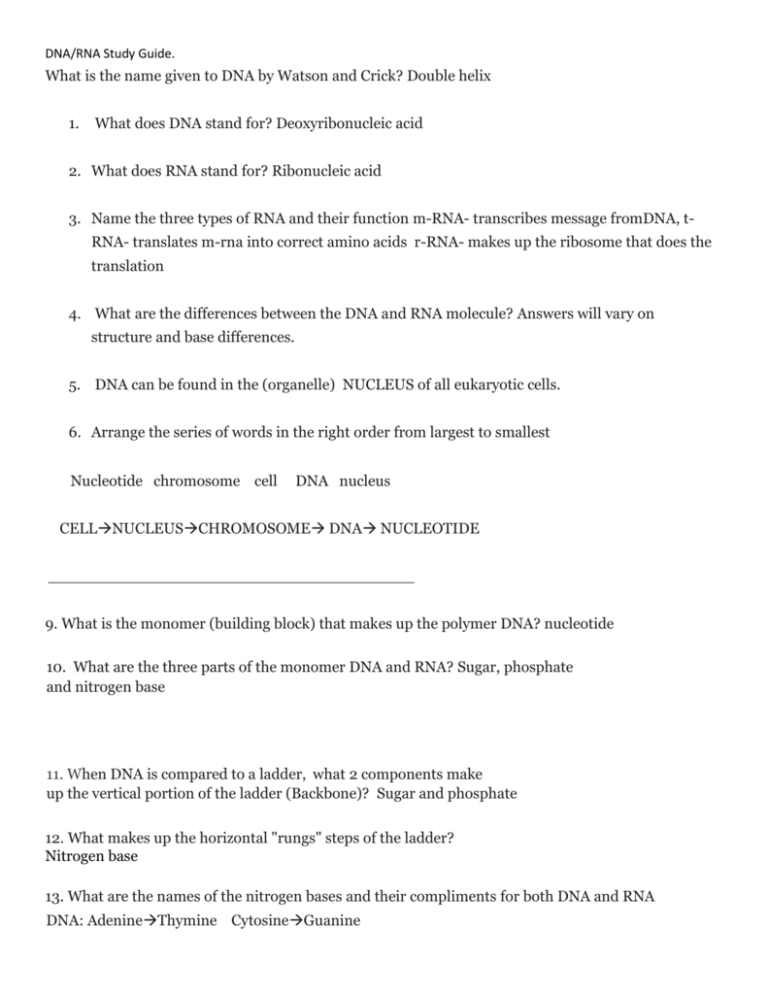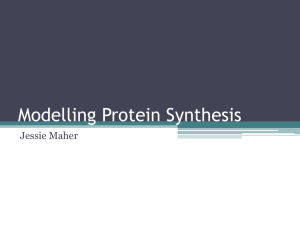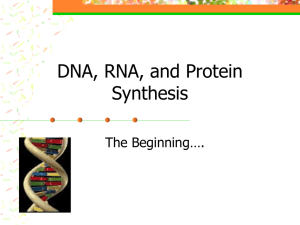DNA/RNA Study Guide. What is the name given to DNA by Watson
advertisement

DNA/RNA Study Guide. What is the name given to DNA by Watson and Crick? Double helix 1. What does DNA stand for? Deoxyribonucleic acid 2. What does RNA stand for? Ribonucleic acid 3. Name the three types of RNA and their function m-RNA- transcribes message fromDNA, tRNA- translates m-rna into correct amino acids r-RNA- makes up the ribosome that does the translation 4. What are the differences between the DNA and RNA molecule? Answers will vary on structure and base differences. 5. DNA can be found in the (organelle) NUCLEUS of all eukaryotic cells. 6. Arrange the series of words in the right order from largest to smallest Nucleotide chromosome cell DNA nucleus CELLNUCLEUSCHROMOSOME DNA NUCLEOTIDE ______________________________________ 9. What is the monomer (building block) that makes up the polymer DNA? nucleotide 10. What are the three parts of the monomer DNA and RNA? Sugar, phosphate and nitrogen base 11. When DNA is compared to a ladder, what 2 components make up the vertical portion of the ladder (Backbone)? Sugar and phosphate 12. What makes up the horizontal "rungs" steps of the ladder? Nitrogen base 13. What are the names of the nitrogen bases and their compliments for both DNA and RNA DNA: AdenineThymine CytosineGuanine DNA/RNA Study Guide. RNA: AdenineUracil Cytosine Guanine 14. What did Chargaff state about how the nitrogen bases are arranged in DNA? Percentage of A is about or equal to T. Percentage of C is about or equal to G in an organism 15. If you were replicating the following strand of DNA what would be its complementary strand? ATCGGCATTAAAGCTAT TAGCCGTAATTTCGATA 16. The process of a cell duplicating (copying) its genetic information is called REPLICATION 17. During which phase of the cell cycle does replication take place? S- Phase 18. At the end of the replication process you have 2 identical strands of DNA ... each strand is made up of one __TEMPLATE(original) strand and one _COMPLEMENTARY(new) strand. 19.What protein (enzyme) is used to unzip the strands of DNA? HELICASE 20. What protein (enzyme) is used to bring in the new nucleotides during DNA replication? DNA POLYMERASE Protein Synthesis Review Protein Synthesis Jobs- Name the structure that do the following jobs in the process of protein synthesis r-RNA t-RNA m-RNA DNA 21a- Helps to transcribe codes in the, must work as a part and in association with the ribosome – r-RNA 21b-Translates information accurately along with transporting and positioning amino acids tRNA DNA/RNA Study Guide. 21c-Maintains genetic code in the nucleus, replicates, and controls cellular activity DNA 21d-Supervises the production of proteins by taking the instructions from the DNA, travels from the nucleus to the cytoplasm m-RNA Transcription 22- What aides in the unzipping process of the DNA to help the transcription process? RNA Polymerase 23- Where in the cell does transcription take place? nucleus 24- What does the process of transcription create? M-RNA 25- What type of RNA is this? messenger 26- Is it single or double stranded? single 27-Each three nucleotide segment is called a CODON 28- Once the RNA segment is created and detaches where does it go? The RIBOSOME 29-Using the following segment of DNA create a mRNA strand: DNA segment: CGA TTA CGG CTT AAG CTA mRNA segment: GCU AAU GCC GAA UUC GAU Translation 30- Where does translation occur? ribosome 31-Where in the cell is the mRNA located to begin this process? ribosome 32- What type of RNA brings the amino acids creating the polypeptide chain to the ribosome? –t-RNA 33- What are the three nucleotide segments on these molecules called? Anti-codons 34- What type of RNA is used to translate the DNA sequence into the correct amino acids? m-RNA 35- What does the genetic code chart show us? the genetic codes that match the codons to the corresponding amino acids 36- What type of RNA is read when using the genetic code chart to locate the correct amino acids- m-RNA 37- A codon is a series of __3__ nucleotides. Every codon is translated into 1 amino acid. Therefore 4 amino acids will be codes for by 4 codons which contain 12 nucleotides. 38- Is it possible for an amino acid to be specified by more than one codon? Why Yes- because are 64 different kind of codons but only 20 amino acids, so more than one combination of codons must code for the DNA/RNA Study Guide. amino acids 39- Explain how the m-RNA translates the information into amino acids. m-RNA moves from the nucleus to the ribosome where it is read three nucleotides at a time by the ribosome. Transfer RNA molecules with attached amino acids match up with their correct codon sequence linking amino acids together until a stop codon is reached, it then breaks off and the protein is created. 40-After translation is completed, what does it result in? A protein (polypeptide) that cell will use for a particular function 41- Using the mRNA strand created above create the tRNA anticodons that would be used to bring amino acids to this molecule. mRNA segment from above: GCU AAU GCC GAA UUC GAU tRNA anticodons: CGA UUA CGG CUU AAG CUA List the Amino Acids that the mRNA codons code for. (Use codon chart) Alanine- asparagine-alanine- glutamic acid-phenylalanine-aspartic acid Mutations 42-What is a genetic mutation? Change in the DNA sequence 43-What are some possible effects when a sequence of DNA is mutated? May express the incorrect amino acid and code for wrong protein for cellular function, or no protein altogether 44- Name the two categories of mutations 1-chromosomal 2-genetic(point) 45- What factors cause mutations to happen? Name some – Environment: UV,radioactive, chemicals, temp, pH, physical manipulation 46-Read the description and fill in the chart below with the correct chromosomal mutations DNA/RNA Study Guide. DUPLICATION, TRANSLOCATION, INVERSION 47- Fill in the chart with a description of what occurs in the following gene/point mutations, then demonstrate the mutation with the given sequence of DNA Substitution Insertion( Addition) Deletion one base is _REPLACED with another when bases are ADDED to the DNA sequence nucleotides are REMOVED, which affects the coding of proteins that use this DNA sequence Normal DNA: TTCGAGG Mutated DNA : Normal DNA: TTCGAGG Mutated DNA : Normal DNA: TTCGAGG Mutated DNA : 48- The type of mutations that result in a frameshift mutation are INSERTION and DELETION 49- In what types of cells are mutations passed down in? SEX CELLS 50- Are you ready for the modern genetics exam? HOPEFULLY!!









